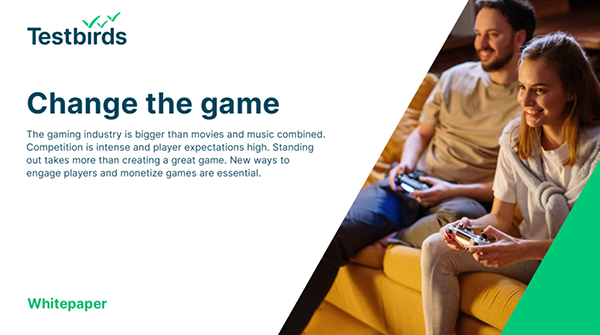Change the game
The gaming industry is bigger than movies and music combined. Competition is intense and player expectations high. Standing out takes more than creating a great game. New ways to engage players and monetize games are essential.
Change the game
The gaming industry is bigger than movies and music combined. Competition is intense and player expectations high. Standing out takes more than creating a great game. New ways to engage players and monetize games are essential.
A long time ago in a generation far, far away, a ten-year-old sat in front of their huge, square TV, and with trembling hands, started up their (parent’s) Atari 2600, inserted a Space Invaders cartridge, and spent many hours in another world.
But give a ten-year-old the same game today and they’ll look at you like you were crazy. Bad sound, bad graphics, boring and slow gameplay, no story, repetition, repetition, and more repetition.
How things have changed. Today’s players are truly spoiled for choice.
Executive Summary
Sports games, puzzlers, MMORPG’s, FPS’s, action-adventure, survival and horror, platformers, MOBA’s, sandboxes (like The Sims, Minecraft, and Roblox), and dozens more. All are available on your device of choice to play when, how, and where you like.
Want virtual reality? No problem.
Complex storylines? Done.
A simple casino-style game? There are hundreds.
Movie-level sound and cinematics, 4K graphics, and more. All are easily streamed or downloadable and ready to play in minutes (if not seconds).
Having so much choice is great for players, but for the gaming industry, it’s a double-edged sword. Earning more than movies and music combined, it’s no surprise that everyone wants their share of the gaming market, and this is seeing the playing field become ever more competitive.
Standing out isn’t just about developing a great game anymore. Players expect more, demand more, and are happy to move on to another game after the smallest issue with yours – while taking to social media so they can tell the world what’s wrong with it and why they move on to another game.
MoreIt’s also clear that success breeds imitators. Before you know it, your unique game can get lost in a crowd of similar ones. And you can’t ignore the diminishing returns of too many sequels and the varied quality of reworked games that might have new, next-gen graphics but little else. Then there’s the problem of games both over-promising what they can deliver and being released with too many bugs and other game-breaking issues.
And because producing a game can take years, there’s no doubt that those coming out in the near future are already well into development. This is part of the problem. They will largely resemble what is seen today. For modern gamers, especially the majority who are casual players, that can get old extremely fast.
The big question to ask is, as gaming producers, what can you do now to differentiate yourself from the competition tomorrow? Three areas will make a difference. Blockchain, the metaverse, and the cloud.
Show less
“In this whitepaper, we take a closer look at each and discuss the overall need to re-adjust business models to keep players happy and engaged and to search for ever-more monetization opportunities.”
Georg Hansbauer, CEO & Co-Founder, Testbirds
The rise of blockchain gaming
Gamers now want that difficult-to-hit mix of familiarity and novelty, and the more time they invest in the game, the more their expectations and emotional connections grow, and the greater their sense of ownership of the game. As any developer knows from reading gaming forums.
All of which is further enhanced by their interactions with the game’s community – others just like themselves – and how well the game’s producers communicate with them.
Rather than games being ‘pushed’ at players, successful ones are being developed that revolve around the game developers’ vision, the players themselves, and the gaming community. Blockchain, alongside non-fungible tokens (NFTs), and crypto-currency/crypto tokens, look to make this a much tighter connection.
For producers, blockchain will provide a new monetization tactic that takes player loyalty and engagement to a completely new level. For gamers, it gives them the chance to own a part of the game they love.
The Web3 future: Controversy and promise For many, Web3’s decentralization is all about revolutionizing the digital world. New platforms, innovative business models, more personal control, and alternate ways for people to increase their investment in games (plus the companies that make them) and even earn money from these unique in-game assets and items. Others, however, see the advent of crypto and NFTs within games as a typical ‘get-rich-quick’ scam. But for younger generations of players, within developing markets, and those looking for secondary incomes, the financial incentives of NFTs and ‘play-to-earn’ games (such as Axie Infinity) are clearly popular. Not only can they generate traditional money via cryptocurrencies, but their NFTs can become an investment that can be traded at a later date (this also includes buying digital land as an NFT, which can be rented out, display advertising, and more).
The Web3 future: Controversy and promise
For many, Web3’s decentralization is all about revolutionizing the digital world. New platforms, innovative business models, more personal control, and alternate ways for people to increase their investment in games (plus the companies that make them) and even earn money from these unique in-game assets and items.
Others, however, see the advent of crypto and NFTs within games as a typical ‘get-rich-quick’ scam. But for younger generations of players, within developing markets, and those looking for secondary incomes, the financial incentives of NFTs and ‘play-to-earn’ games (such as Axie Infinity) are clearly popular. Not only can they generate traditional money via cryptocurrencies, but their NFTs can become an investment that can be traded at a later date (this also includes buying digital land as an NFT, which can be rented out, display advertising, and more).
This can also lead to token-owning players participating in the game’s DAO (decentralized autonomous organization – which has no central authority, and its power is distributed across all token holders), where they can be involved in deciding the direction of various parts of the game. There are, of course, many challenges to setting up a gaming environment that delivers the required security and interoperability.
A significant issue for the general public is a lack of understanding about the technologies involved. Do they know enough about cryptocurrencies to effectively, and securely, manage a crypto wallet? What about their private keys (exceptionally long passwords) that enable them to access their crypto assets? Within the game, how do they earn NFTs? Do they need to initially buy an NFT to even play the game?
Providing detailed, yet easy-to-understand information is essential to build awareness, acceptance, and trust.
A quick look at the tech
Web 3.0 is the third generation of the internet and places decentralization, transparency, and security at its core, providing users with far more personalized experiences and control over their data.
Blockchain technology is an immutable, shared, and transparent digital ledger that is formed using unchangeable records (blocks) linked together via cryptography.
A cryptocurrency is a digital currency stored, and traded, on blockchain technology without being reliant on any central authority (such as a government).
Non-fungible tokens are unique digital assets that use blockchain technology to be created, bought, and traded (usually via the Ethereum blockchain).
On the development side, appropriate APIs and blockchain protocols (especially for NFTs), such as Ethereum or Flow, must be investigated and tested to ensure digital assets are safely and reliably handled.
Are in-game tokens securely distributed and can on-chain assets be assessed?
Should you use blockchain nodes or use blockchain-as-a-service (from SAP, HP, IBM, Azure, and many more)?
What is your blockchain’s transaction speed? The faster the better.
What transaction fees do they charge? The lower the better.
Ultimately, whether only providing in-game NFTs and/or cryptocurrencies or developing an entire experience around a play-to-earn model, Web3 and blockchain offer the opportunity to directly tailor games to the player and explore a range of other development models, such as subscription gaming and cloud-based streaming.
Importantly, these technologies are also converging into one of the biggest digital movements today, the metaverse.
Virtual gaming and the metaverse
As the world’s gaming audience asks for a more mobile and casual gaming experience, the traditional ways of releasing games may soon be outdated. It won’t be enough to deliver a big game once a year to PC and the big consoles with (maybe) a few minor DLCs along the way. Even standing out in the sea of mobile games will require rethinking. New ways of providing gaming experiences are needed – from subscription gaming, to cloud-based streaming, and fully immersive experiences.
When it comes to immersive, the metaverse aims to do this and much more. Through a combination of 3D graphics, social networks, gaming, shopping, digital workplaces, and innovative technologies including virtual reality (VR) and augmented reality (AR), the idea is to create a fully immersive digital world where people can socialize, play, be entertained, and do business.
It may be over-hyped today but with billions being invested into it – and with an estimated market value of $5 trillion by 2030 – the metaverse (or at least its potential) can’t be ignored. And with a quarter of the world predicted to spend at least one hour a day in the metaverse by 2026, the time spent gaming may be significant.
We’ve already seen hints of what gaming can do with the metaverse, from Roblox’s hosted events to Fortnite, with their virtual concerts. Even fashion brand Louis Vuitton developed a game that makes use of various metaverse elements, such as collecting and unlocking items and being able to trade found tickets for an NFT version of other in-game items.
But one of the metaverse’s biggest potentials will be the use of VR and AR. To gain a glimpse of that potential, just consider 2016’s huge mobile gaming hit, Pokémon Go, and its use of AR in real-world conditions.
The immersive advantage – from competition to connection
As smartphones, wearables, and headsets become more affordable and mainstream, and as technologies improve to the point that live streaming is common and a mobile device is as powerful as a modern PC or console, the proliferation of a huge variety of VR/AR games is guaranteed.
It’s also worth considering tomorrow’s technologies. Smart contact lenses could revolutionize AR while virtual skin can make VR feel extremely real. Combine that with the latest in real-time ray tracing, and mixed reality games will become highly realistic and far more immersive.
While gaming will still be about escapism, connecting with other players will become equally important. Experiences, both familiar, novel, and enhanced, will become far more immersive and connected.
Especially as cloud gaming and streaming become standard.
Comparison Study
Thinking about an A/B test? We have a better solution with real outcomes on your KPIs. Find out what your users prefer and most importantly – why.
Find out moreJoin the cloud
As network infrastructures and internet connections improve around the world, and as more technologies make full use of 5G and WiFi 6, the live streaming of games (cloud gaming or gaming-as-a-service) is set to surge – especially on mobile devices and wearables.
This isn’t to say everything is going smoothly right now. Apple’s cloud gaming ban on its App Store is still proving to be a roadblock for iOS users and gaming developers, while Google is shutting down its Stadia cloud gaming service in January 2023. Dozens of others, however, are more than filling the void. In particular, Microsoft’s Xbox consoles are getting in on the action via their Xbox Game Pass Ultimate service, as is NVIDIA with GeForce NOW.
For players, the benefits are clear.
They can play games on virtually any device …
More(depending on the service). PC players don’t need to continually update expensive hardware to keep playing the latest games. All, in many cases, aren’t required to download any software (including patches and updates), which (especially for consoles and mobile devices) drastically saves hard drive space. Players can even cast the game to other devices.
The only significant drawbacks are if your internet goes down (no playing at all), if your provider isn’t the best (annoying lag or dropouts), or if the service tier you select has too much latency.
Additionally, as everything goes digital, this will have a cross-over effect with non-cloud gaming. Online-only games, which are still downloaded to a PC or console (but only playable via dedicated servers or a peer-to-peer network), will continue to rise. It is also likely in the coming years that digital sales are going to fully replace physical copies of a game, which will further boost online-based content and fully dedicated cloud gaming.
Show lessHow Qobuz uses crowdtesting to meet customer demands for quality
The subscription business model
One aspect that gaming developers must focus on is the rise of the subscription model. As with media streaming, consumers are embracing the convenience of paying a monthly fee to access all the content they want. This is quickly happening with gaming.
For many, consoles are leading the way. From PlayStation Plus to Xbox Game Pass and Nintendo Switch Online, add-ons, perks, and 100’s of games (TV shows and movies) are made available on different tiers. Pay more, get more. Other services may offer a limited selection that’s free to play or that requires players to buy each game separately.
MoreBut one thing is clear, as cloud services mature and more organizations become involved, player subscriptions will increase (this is already being seen with Apple Arcade and Amazon Luna). And that means in the coming years it will be vital to ensure that your game is supported on the cloud service of your choice.
Ensuring gamers can play your game how they want, when they want, and wherever they are is a clear competitive advantage. The cloud just may be the answer.
Show lessChange the game
Playing the long game
The time, cost, and complexity of creating a game means you can’t miss any opportunity to engage (and keep) your players, maximize what you have, and find new things to entice gamers to give your game a try. This doesn’t matter if you’re creating a smaller indie game or a triple-A Hollywood-level blockbuster.
With so many competitors out there looking to win that final boss battle, it’s worth seriously considering what’s just gaining traction today, because blockchain, immersive gaming, and the cloud just might be tomorrow’s Most Effective Tactics Available.



